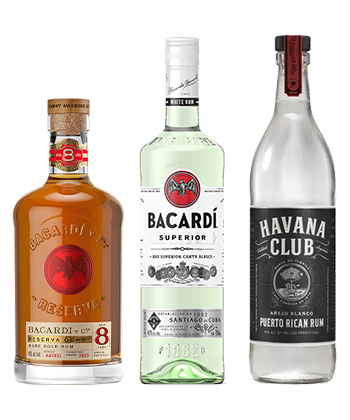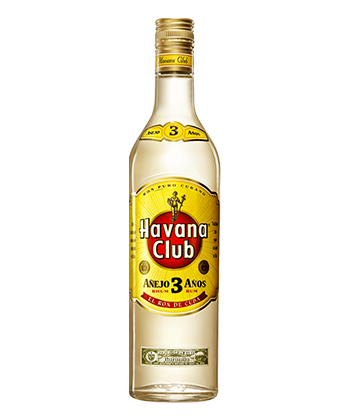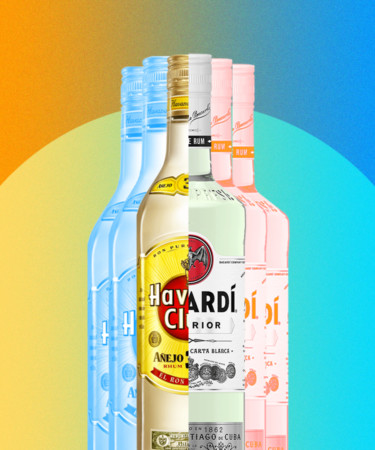Two rival rum-producing families, a Communist takeover, and decades of legal wrangling and public relations posturing, the stories behind Bacardí, Havana Club, and their ongoing trademark battle is more complicated than you might think.
According to The Spirits Business, Bacardí reigns as the world’s second-largest rum producer, having sold more than 17 million cases in 2019, while Havana Club comes in fifth on the list, with over 4 million cases sold.
Today Bacardí is associated with the island of Puerto Rico, but like Havana Club, has its roots in Cuba. And while Bacardí’s extensive range of rums can be found at liquors stores across the country, due to the Cuban goods trade embargo established in 1962, the Havana Club produced in Cuba is still unavailable in the U.S. Adding to the muddled history, a Bacardí-owned product also named Havana Club is sold in the U.S., but more on that below.
Origin

Bacardí was founded in Cuba after Don Facundo Bacardí Massó, a Spanish immigrant and wine merchant, found himself professionally at a crossroads. After two earthquakes and a cholera outbreak led to the looting of his wine business, Massó was forced to declare bankruptcy.
Inspired by what he perceived as a gap in the liquor market, he set his sights on producing a rum that would appeal to Cuba’s emerging middle class. In 1862, that dream became a reality after he opened La Tropical, a small distillery in the city of Santiago, Cuba.

More than a decade after Bacardí popularized its signature light rums, José Arechabala founded the distillery known as La Vizcaya in Cárdenas, Cuba in 1878. In 1934, Arechabala began producing Havana Club — a brand that became a hit in the U.S. market.
Following Fidel Castro’s revolution in late 1959, though, both families were forced into exile, and Cuba’s rum industry was nationalized.
Production
As detailed in The Washington Post, after the Arechabalas fled Cuba, the family struggled to find financial backing to continue their rum business and eventually found work in other industries, effectively letting its U.S. “Havana Club” trademark lapse. Bacardí, on the other hand, maintained its trademark and yeast strain, successfully moving its rum production outside Cuba.
When the Arechabalas lost their trademark in 1973, the Cuban government filed for the same trademark in 1976. Then in 1993, the French liquor conglomerate Pernod Ricard and the Cuban government entered into a partnership to produce and export the island’s rum. The joint venture proved advantageous, with global sales jumping to more than 1 million cases a year.
In 1994, Bacardí also filed for the U.S. Havana Club trademark, but scored a PR coup by first entering into a $1.25 million deal with the Arechabala family for rights to the original recipe and trademark. Thus began a multi-decade clash between the two industry titans for American rights for the “true” Havana Club.
As to how both brands were permitted to sell “Havana Club” products, Reuters explains: “The United States previously recognized Bacardí’s claim to Havana Club under a statute aiming to protect owners of Cuban companies nationalized after Fidel Castro’s rebels came to power. Meanwhile, everywhere else in the world, the name belonged to Cuba through the joint venture between Cubaexport and Pernod Ricard.”
The feud still rages today, with Bacardí selling its Havana Club products in the U.S. and staking a claim of authenticity in its deal with the Arechabala family and Pernod Ricard arguing that the only true Havana Club is made in Cuba.
Flavor
According to VinePair writer Vicki Denig, Bacardí Silver has “lively citrus flavors” that make it the perfect complement with mint in a Mojito, while on the palate, Bacardí 8 Anos (which now goes by Reserva Ocho) is dominated by “dried fruit and baking spices.” Bacardí’s Havana Club Añejo Blanco, based on the original 1934 Havana Club recipe, is a “citrusy, salt-tinged rum [that] is perfect for the summer.”
Denig describes the Cuban Havana Club 3 Year as “light in color yet powerful in flavor” with a palate that is “mild, fruit-forward, and slightly citrusy.”
Use in Cocktails
From classics like the El Floridita, named in honor of the bar in Havana where Ernest Hemingway famously enjoyed the variation on the Daiquiri, to the Piña Colada, a drink believed to have been invented in Puerto Rico, rum is beloved by bartenders for its diversity and universal appeal. Of course, a simple rum and Coke is one way to go, but for many rum aficionados, the best way to appreciate the beauty of the spirit is on its own with a cube of ice.
Why the Pros Like Each
Kelly Verardo, the brand bar manager at Osteria Morini likes Bacardí for cocktails but says the Cuban Havana Club is definitely worth a try: “If you see the bottle with the yellow label with a big red circle, I recommend trying it, even just for bragging rights. But also, it’s delicious, with more caramel notes than an unaged rum will provide.”
VinePair writer Nick Hines, who tried the Cuban-made Havana Club while in Thailand, says it’s the “best affordable rum brand out there,” and describes the Havana Club 3 Year as “both thirst-quenching and dry” with a “tannic quality and a vanilla flavor.”
For Hines, part of the brand’s appeal lies in what he considers to be its authenticity: “Havana Club is made by maestros roneros or master rum makers in Cuba. They distill molasses from Cuban sugar cane, and then blend different barrels for the optimum flavor … and, like it or not, authenticity affects the drinking experience.”
